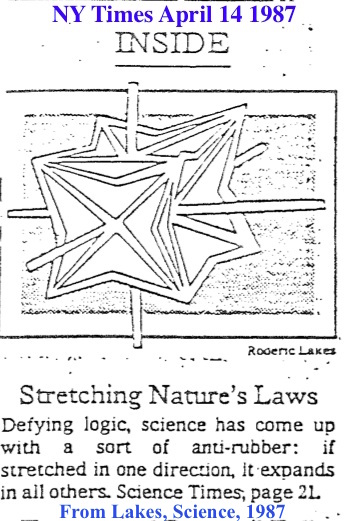Selected Publicity
This page on selected publicity has been added because it has become commonplace to do so. A fraction of such material was retained and is presented here.
Negative Poisson's ratio materials
The materials have been described in The New York Times 14 April 1987. The idealized unit cell from the original Science article appeared on the front page of the New York Times as shown on the right.

Articles also appeared on the front page of The Chicago Tribune no. 218, Sunday 6 Aug. 1989; Science News, 14 March 1987; Chemical Week, 1 April 1987; The St. Paul Pioneer Press Dispatch, 14 April 1987, The Denver Post, 14 April 1987; The Des Moines Register, 16 April 1987; Scientific American, May 1987; Voice of America, May 1987; The London Sunday Times, 3 May 1987; KGAN TV, 19 May 1987; The Financial Times of London, 20 May 1987; The London Daily Telegraph, 24 May 1987; CNN TV News, 26 June 1987; Beyond 2000 TV [Australia], Aug. 1987; L'Usine Nouvelle, 1 Oct. 1987; Soma, Oct. 1987; The Des Moines Register, 22 Nov. 1987. The materials were also described on BBC Television, The Voice of America, and CNN News.
"Antirubber", page 208-209 in The Almanac of Science and Technology, ed. R. Golob and E. Brus, Harcourt Brace Jovanovich, Publishers, Boston, San Diego, New York, 1990
Wired Brendan Cole, "A Freaky Anti-rubber is Still Weirding Scientists Out",
Wired, 1 Aug. 2016
Negative stiffness
Physics Today 60(4), 18 (2007); doi: 10.1063/1.2731959 feature
Physics Focus Blurb
Science magazine: Science Now http://sciencenow.sciencemag.org/cgi/content/full/2001/403/3 Blurb, a dry link
Nature Physics Portal Research Highlights
Blurb
Ruhr University, Germany
Science Daily
Finding May Unshackle The Potential Of Composite Materials.
Summary:
In an advance that could lead to composite materials with virtually limitless performance capabilities, a University of Wisconsin-Madison scientist has dispelled a 50-year-old theoretical notion that composite materials must be made only of "stable" individual materials to be stable overall.
Rock-solid option The Engineer, UK
Engineers at the University of Wisconsin-Madison in the US have recently developed a unique barium titanate and tin composite that is the first material known to be stiffer than diamond.
Materials World NEW 'EXTRALIBRAL' COMPOSITE 'STIFFER THAN DIAMOND'
Materials World magazine, 1 Apr 2007. Diamond's title as the world's stiffest material may have been usurped by a new composite made up of molten tin and the mineral barium titanate.
Science News 159, p. 285, May 5 2001 link has gone dry.
Design news dry link http://www.designnews.com/community/43654/Materials%2FFastening.html�
Novel lattices
Advance could enable novel high-performance materials, phys.org, 2018.
Researchers Use 3D Printing to Create Super-Strong Material 3dprint.com, 2018.
